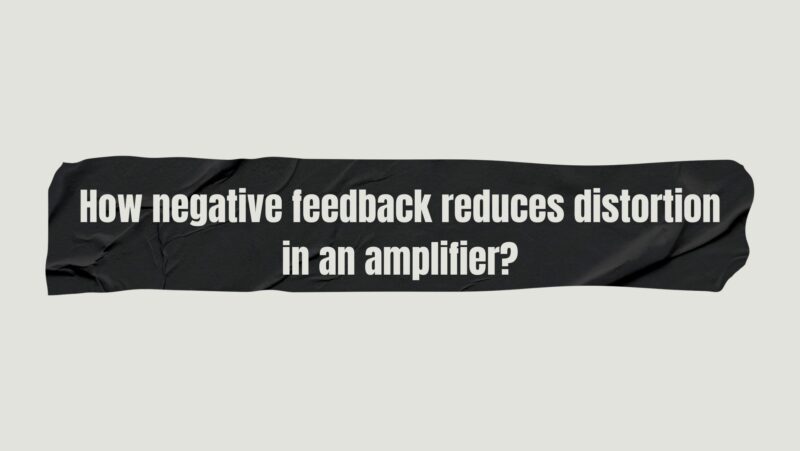In the realm of audio amplification, achieving accurate and distortion-free sound reproduction is a pursuit that captivates both audio engineers and enthusiasts. Distortion, an undesirable alteration of the original audio signal, can compromise the quality of music and sound. Amidst the myriad techniques employed to mitigate distortion, one approach stands out: negative feedback. This article delves into the intricate world of negative feedback in amplifiers, exploring how it works to reduce distortion, the mechanisms involved, and the implications for achieving pristine audio fidelity.
Understanding Negative Feedback
Negative feedback is a fundamental concept in electronic systems, including audio amplifiers. It involves the process of taking a portion of the output signal and feeding it back to the input, but in reverse phase. The result is a control mechanism that can regulate the behavior of the amplifier circuit and, in the context of audio amplification, enhance linearity and reduce distortion.
The Mechanism of Distortion in Amplifiers
- Harmonic Distortion: In amplifiers, harmonic distortion occurs when the output signal contains frequency components that were not present in the original input signal. These additional harmonics result from nonlinear behavior within the amplifier’s components.
- Transistor Nonlinearity: Amplifier stages often use transistors for amplification. Transistors exhibit nonlinear characteristics, causing them to amplify input signals unevenly and generate harmonic distortion.
Negative Feedback’s Impact on Distortion
- Cancellation of Nonlinearities: Negative feedback addresses the inherent nonlinear behavior of amplifier components by applying a counteracting signal. This signal cancels out the distortion-producing nonlinearities, resulting in a more linear overall response.
- Reducing Odd Harmonics: Negative feedback has a greater impact on odd-order harmonics, such as third and fifth harmonics. These are the most audible and objectionable types of harmonic distortion.
Balancing Trade-offs: Open-Loop vs. Closed-Loop Gain
- Open-Loop Gain: In the absence of feedback, amplifiers operate in an open-loop configuration with high gain. While this configuration offers high amplification, it can also result in significant distortion.
- Closed-Loop Gain: Negative feedback reduces the effective gain of the amplifier, shifting it from open-loop to closed-loop operation. This trade-off between gain and distortion is a central consideration in amplifier design.
The Role of Loop Gain and Phase Shift
- Loop Gain: The amount of negative feedback applied to the amplifier is determined by the loop gain—the gain around the feedback loop. Higher loop gain results in stronger negative feedback and greater distortion reduction.
- Phase Shift: Proper phase relationship between the input and feedback signals is crucial. Phase shifts can destabilize the feedback loop and introduce additional distortion if not managed correctly.
Stability Considerations
- Phase Margin: Amplifiers with negative feedback must maintain a sufficient phase margin to ensure stability. Excessive phase shift can lead to oscillations and instability.
- Compensating for Phase Shift: Compensation techniques, such as Miller compensation, are employed to address phase shifts and maintain stability in feedback loops.
Implications for Audio Fidelity
- Improved Linearity: Negative feedback enhances the linearity of amplifiers, reducing the nonlinear distortions that compromise audio quality.
- Reduced Harmonic Distortion: By canceling out odd-order harmonics, negative feedback significantly reduces the types of distortion most noticeable to the human ear.
Challenges and Considerations
- Timbre Changes: Excessive negative feedback can alter the timbre or tonal character of the sound, making it crucial to strike a balance between distortion reduction and sonic neutrality.
- Trade-offs with Loop Gain: Increasing loop gain for stronger negative feedback improves distortion reduction but can also impact bandwidth and stability.
Conclusion
The integration of negative feedback in audio amplifiers serves as a potent tool in the battle against distortion. By applying a portion of the output signal in reverse phase to the input, negative feedback counters the nonlinearities that give rise to harmonic distortion. The delicate balance between loop gain, phase shift, and stability determines the success of the feedback mechanism in achieving pristine audio fidelity. Audio engineers and enthusiasts alike harness the power of negative feedback to sculpt amplifiers that offer the perfect blend of high amplification, reduced distortion, and accurate sound reproduction. As technology advances and techniques evolve, the pursuit of optimal audio quality continues, guided by the principle that precision and refinement elevate the auditory experience to new heights.


